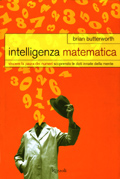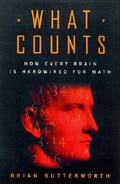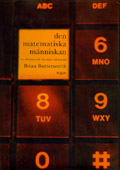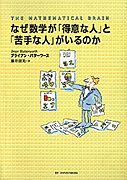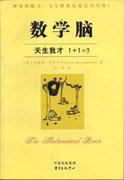Most people nowadays who claim to lack a 'mathematical brain' can easily sit
down to multiply 231 by 34 or divide 2119 by 138 and come up with the
answers. Yet in the 15th century Northern European merchants had to send
their mathematically gifted sons to Italy to learn how to accomplish these
feats. Arabic numerals were not yet in wide use, and German universities
weren't the place to find out about the arcane arts of multiplication and
division. Before smiling indulgently, however, try multiplying the Roman
numerals DCL and MLXXXI or dividing MDCCCVII by CCLXIV without first
translating them into our own system of numerals. So who has more number
smarts, the present-day self-styled innumerate or the mathematically
gifted German student from five hundred years ago?
Brian Butterworth, a cognitive psychologist who has done much work on
the neural and cognitive bases of mathematical thinking, says it's a tie.
The thesis of The Mathematical Brain is quite simple. The left parietal
lobe of the brain contains certain specialised circuits, which Butterworth
terms the Number Module, that enable all of us to recognise small numbers
automatically, to match up the elements of small collections of objects,
and to tell which of them is the larger. We unthinkingly perform these
tasks and others depending on them in something like the way we take note
of colours without consciously trying to do so.
Any numerical achievements beyond this (multiplying and dividing, for
instance) are a result of our slowly mastering various conceptual
representations of numbers as determined by the surrounding culture. These
include body parts - fingers primarily, but, as Butterworth notes, for the
Yupno people of New Guinea, other appendages as well, ranging from nipples
to penises - specialised counting words, external aids such as tallies and
calculators, and written symbols such as Roman or Arabic numerals. Other
cultural tools enable us to master more advanced mathematical notions such
as probabilities, differential equations and infinite sets.
Nevertheless, Butterworth claims that we all start with the same basic
equipment, the basic mathematical brain. To establish this claim and
defend it against rival accounts, he conducts a fascinating, if at times
maddeningly repetitive, tour of the relevant research in neural and
cognitive psychology, digressing occasionally into general psychology,
ethnography, ethology, history, mathematical pedagogy and, near the end of
the book, some real mathematics. The whole thing is reminiscent of
Stanislaus Dehaene's The Number Sense, but without that book's
reductionist claims that numbers are somehow present in our brains and
virtually a social construction. I was reminded also of Oliver Sacks's The
Man who Mistook His Wife for a Hat, since many of the stories of stroke
patients included here have a 'man who mistook his 5 for an 8' flavour.
Butterworth begins by describing at length various concrete means of
indicating numbers: markings on bones and rocks, pebbles of different sizes,
Egyptian hieroglyphics, the ubiquitous abacus and counting
board, and, finally, the most personal of personal computers - human
hands. Bede devised methods for counting up to a million using the hands,
but counting on our fingers is an almost universal phenomenon, ultimately
giving rise to the most commonly used written bases. Our base-10 system
derives from it, while the French words for 20, 80 and 90 - vingt,
quatre-vingt, quatre-vingt-dix - imply an older base-20 system (most
likely the result of counting on fingers and toes). The Maya, one of
several peoples to invent the principle of positional notation, also used
a base-20 System 1,500 years ago to create calendars more accurate than the
Gregorian one we use today. Even the ancient Babylonian-Sumerian base-60
system, which survives in our measurement of time, angles and geographic
position, was probably derived from finger counting.
We are also given a historical sketch of methods of numerical
representation: abstract symbolisation; the tally, collection and
composition principles that led on to the idea of a multiplicative base
for numerical systems (e.g. base-10); positional notation (826 is very
different from 628 or 682); and the holy grail, the invention of zero
(allowing us to distinguish easily between 36, 306, 360 and 3006) - all
of which are an essential though almost invisible part of our cultural
heritage. It is one of the virtues of The Mathematical Brain that it makes
this heritage not only visible but vivid. just how much we take it for
granted is underscored by the hoopla surrounding the year 2000. To deflate
this numerologically inspired enthusiasm, I note that had we adopted a
base-8 system of numeration, the year 2000 would be indicated by the
numeral 3720 (3 x 83 + 7x82 + 2 x 81+ 0 x 1),
a representation much less likely to induce celebration.
Butterworth takes great pains to establish that number notions, words
and representations are not, as our alphabet certainly is, an invention
that spread from a single source. Rather, he argues, they are part of our
neural hardware. To this end he cites evidence drawn from prehistoric cave
paintings and markings, the seemingly innate number sense of infants, as
well as animals' abilities in a mathematical direction.
What do we know, in fact, of the relationship between very small people
and very small numbers? The book describes,experiments in which babies are
presented with a series of white cards on which two black dots have been
placed. Each card in turn is placed a few inches from the babies' eyes and
the length of time they stare at it is noted. The babies soon lose
interest but extend the length of their stares once again when the cards
are changed for ones carrying three dots. After a while they lose interest
in these, but regain it when again shown a card with only two. The babies
appear to be responding to the change in number and to be disregarding
the colour, size and brightness of the dots.
On the strength of such evidence, Butterworth claims that the babies have
a rudimentary sense of arithmetic. (The other researchers he cites agree
with him.) In another experiment, two dolls are placed behind a screen in
front of them, but only one remains when the screen is removed. The babies
are surprised, as they are when one doll placed behind the screen somehow
becomes two on removal of the screen. They are not surprised, on the other
hand, if two dolls turn into two balls or a single doll into a single
ball. The conclusion he draws is that the babies are aware that one and
one make two, and that violations of arithmetic are more disturbing to them
than changes of identity.
This seems dubious. There is ample room for an experimenter's
expectations to skew the statistics, for example. And if a baby looks at
an object for three seconds, looks away for two, and then looks back for
two more, is this counted as looking at it for three seconds or for seven?
It's possible, too, to find alternative theoretical explanations for the
phenomena in question, something that's even more true for the research
being done into the number notions and arithmetic skills of chimps and
other animals.
In attributing a well-developed sense of number to small children,
Butterworth is taking issue with Piaget, who believed that a child's
numerical understanding is based on a long developmental process: children
must first master principles of transitivity, conservation and so on
before they can be said, at the age of five or so, truly to understand
numbers. In one of Piaget's classic experiments younger children are shown
two identical sets of objects. After the experimenter has spread one of
the sets out, the children commonly say that it has more objects in it
than the other. Butterworth's criteria for ascribing a number sense to
children are looser than Piaget's, but it does now appear that young
children know more about numbers than Piaget thought, although perhaps not
as much as Butterworth claims.
Butterworth's general position is more compatible with that of Chomsky,
who has argued for decades that the logic of grammar is hard-wired into
our brains and forms an innate cognitive structure. But he parts company
with Chomsky when it comes to the origins of the concept of number.
Chomsky conceives of it as a special aspect of language, whereas
Butterworth believes our numerical notions originate in the Number Module,
or those specialised circuits in the left parietal lobe, a claim that
finds support in what occurs in victims of brain disorders, with their
resulting cognitive deficits and coping strategies. An Italian woman has a
stroke, for example, which damages her left parietal lobe and, although
her language abilities are unaffected, she can no longer tell without
counting whether there are two or three dots on a sheet of paper.
An Englishman with Pick's disease can barely speak but retains his ability
to calculate. An Austrian woman with a tumour in the left parietal lobe
cannot connect the arithmetic facts she recites in a singsong way to any
real-world application of them. One patient understands arithmetic
procedures but can't recall any arithmetic facts, while another has the
opposite condition.
Particularly intriguing is Gerstmann's syndrome, two of whose salient
characteristics are finger agnosia (an inability to name one's own fingers
or point to them on request) and acalculia (an inability to calculate or
do arithmetic). Butterworth's theory here is that during a child's
development the large area of the brain controlling finger movements
becomes linked to the circuits of the Number Module, and the fingers come
to represent numbers. (It's interesting, too, that the 'reading finger'
of a Braille reader is associated with considerably more brain cells than are
the other fingers.) I am interested in using narrative - stories,
vignettes, scenarios - to impart mathematical ideas to the young, and
although Butterworth doesn't devote much time to this Chomskyian issue,
one must assume that the large areas of the brain involved in the
development of language also become linked to the Number Module.
Since the Module must be similar in everyone in whom it develops
normally, Butterworth argues that the primary reasons (sometimes he
appears to be saying the only reasons) for disparities in mathematical
achievement are environmental - the quality of teaching, the amount of
exposure to mathematical tools, motivation. He cites the burden imposed on
students by the cumulative nature of mathematical ideas and points to the
self-perpetuating nature of different attitudes to the subject,
contrasting in particular the virtuous circle of encouragement, enjoyment,
understanding and good performance leading to more encouragement, with the
vicious circle of discouragement, anxiety, avoidance and poor performance
leading to more discouragement.
Butterworth reports on the huge disparities between the performance of
students from different countries - the score of the average Iranian
student is higher than that of only 5 per cent of students from Singapore,
for example - to bolster his fairly obvious contention that local
curriculum and standard of teaching are highly influential. His
pedagogical prescriptions near the end of the book are more or
less on the mark (although they don't follow from the neural
and cognitive findings in the earlier parts): more emphasis should be
put on applications that interest students; mathematics should be made
a more engaging subject, via the use of puzzles and games, for example,
there should be emphasis on drill and rote memorisation, although some
drill is needed, so long as it's not mind-numbing long division; there
should be greater freedom for students to discover mathematical notions,
or at least play around with them, on their own. What Butterworth doesn't
cite, however, is the evidence we have that discovery learning of this sort
isn't very effective in the less elementary areas. Very few students are
going to come up with the Poisson distribution or the fundamental theorem of
calculus on their own.
The best thing about The Mathematical Brain, its scope and variety, is
related to its main weakness, its bagginess. The superiority of Chinese
number names, the Indian mathematical genius Ramanujan, this patient or
that with an obscure neurological deficit, Pascal's triangle,
Indo-European number words, and dialects in finger counting - all these
find a place. And for no apparent reason, an appendix even contains an
outline of Gödel's incompleteness theorem. Anyone interested in the
development of numeracy has plenty to go on in this engaging book.
John Allen Paulos is the author of Once upon a Number,
among other
books.
© London Review of Books, 2000.
 Confidence Counts
Confidence Counts